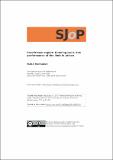Files in this item
Practitioner report: running walls: the performance of the limit in prison
Item metadata
| dc.contributor.author | Maccagno, Paolo | |
| dc.coverage.spatial | 28 | en_US |
| dc.date.accessioned | 2015-08-14T11:20:31Z | |
| dc.date.available | 2015-08-14T11:20:31Z | |
| dc.date.issued | 2015-06-26 | |
| dc.identifier.citation | Maccagno, P., (2015). Practitioner report: Running walls: the performance of the limit in prison. Scottish Journal of Performance, 2(2), pp. 33–59. | en_US |
| dc.identifier.issn | 2054-1961 | en_US |
| dc.identifier.uri | https://hdl.handle.net/10023/7226 | |
| dc.description.abstract | The limit to freedom, represented by the wall of the prison, is the limit to run to reach the finish-line of the marathon: run the limit! Training prisoners to run a marathon as a practice of the limit. Inside and outside meet on the limit, in a suspended place where running is a movement of rehabilitation and transformation. Go Daddy! is an educational project based upon the pedagogy of resilience and a form of anthropological research into body and movement. It is a case study investigating personal limits through an art performance based on marathon running with prisoner-fathers; a limit- experience as a ‘practice of freedom’ (Foucault) to activate the prison and through it see a social system where neoliberalism is expressed; a pilot project for wider research at the intersection of different academic traditions, pointing towards a new direction for critical engagement with performance. Drawing from that experience, this article examines the potentialities of marathon running in prison as a performance of limits: a healing possibility for personhood to be based on ‘presence’ (Abramović) and awareness, since, as Foucault notes, the experiential body can become a locus of resistance against normalising power . Through analysis of the Go Daddy! project, this paper considers how an art performance can be an experiment in the sense not of testing a hypothesis but of opening an exploratory path of inquiry into human life and a new way of conducting anthropology as a learning process —in other words, the possibility for art to be science. | en_US |
| dc.language.iso | en | en_US |
| dc.publisher | The Royal Conservatoire of Scotland | en_US |
| dc.relation.ispartof | Scottish Journal of Performance | en_US |
| dc.rights | This work is licensed under a Creative Commons Attribution 4.0 International License. | en_US |
| dc.rights.uri | http://creativecommons.org/licenses/by/4.0/ | |
| dc.subject | Marathon | en_US |
| dc.subject | Running | en_US |
| dc.subject | Prison | en_US |
| dc.subject | Walls | en_US |
| dc.subject | Presence | en_US |
| dc.subject | Limit | en_US |
| dc.subject.lcc | PN1576 | en_US |
| dc.subject.lcsh | Performing arts--Research | en_US |
| dc.title | Practitioner report: running walls: the performance of the limit in prison | en_US |
| dc.type | Report | en_US |
| dc.description.version | https://doi.org/Publisher PDF | en_US |
| dc.publicationstatus | Published | en_US |
| dc.status | Peer reviewed | en_US |
| dc.identifier.doi | https://doi.org/10.14439/sjop.2015.0202.03 | en |
This item appears in the following Collection(s)
Except where otherwise noted within the work, this item's licence for re-use is described as This work is licensed under a Creative Commons Attribution 4.0 International License.
Items in the St Andrews Research Repository are protected by copyright, with all rights reserved, unless otherwise indicated.


